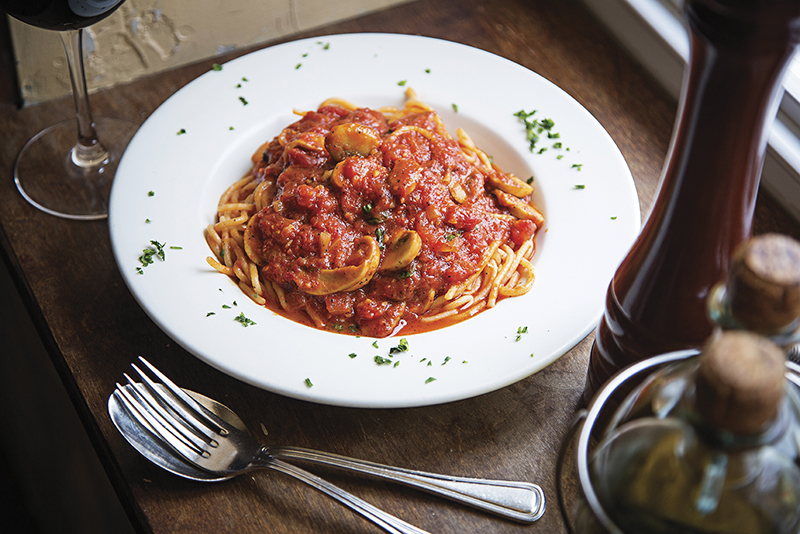Food & Drink
Test of Time
La Scala still has it after all these years.
At a time when menus at the hottest trattorias boast trendy ingredients like artisanal spelt pasta and house-made burrata, Baltimore still loves its old-school Italian restaurants—you know, the kind with a brightly colored mural of the Bay of Naples on the wall and a nice, thick veal alla Parmigiana on the menu. And although a spate of “red sauce” restaurants have closed in Little Italy over the past few years, anyone who has tried to park there on a Saturday night knows that plenty of folks still want a simple plate of penne al ragú like nonna used to make, even if they didn’t have a nonna.
Among the titans of tradition in the ’hood, La Scala may not be the oldest—it’s only been around for 20 years—but it certainly is one of the best. Chef-owner Nino Germano (not to be confused with Germano Fabiani of the eponymous Germano’s Piattini nearby) isn’t in the game to break new culinary ground; he just prepares the standards with good ingredients and solid technique, a formula that yields precisely the food you want when you’re looking for familiar Italian favorites.
Germano is Sicilian, but his menu cannily encompasses a veritable cook’s tour of Italy—from elegant Northern seafood and cream-based specialties like risotto mare e monti and fettuccine Alfredo to the earthier tomato-based cuisine of Naples, including an excellent rendition of ragú-topped pasta and a lively puttanesca. The most radical item you’ll find on a menu dotted with various meats prepared alla Marsala and alla Parmigiana is the gamberi luana—shrimp, olive oil, garlic and “a touch of Old Bay” over linguini. A fairly extensive salumeria menu of cured meats, artisanal cheeses, and marinated vegetables is the only concession to trendiness. But let’s face it—in Italy, restaurants have been offering salumi since forever, so the “trend” is actually older than old school.
Similarly, the décor at La Scala will remind you of the Italian restaurants of your childhood, with warm brick walls and plush carpeting, mementos and memorabilia from Sicily, and the ubiquitous mural—here, a skyline of Germano’s hometown of Bafia—gracing the main dining room. There’s a cozy and often crowded bar downstairs, an impressive wine room, and, of course, an indoor bocce court, added when the place expanded in 2008.
Among the titans of tradition in the ’hood, La Scala may not be the oldest, but it is certainly one of the best.
Our waiter immediately placed a dish of fresh green beans in garlic and olive oil and a basket of warm bread on the table, a nice touch. After that, give up any notion of eating sensibly here and start, like we did, with polenta alla griglia, thick squares of grilled polenta smothered in a rich cognac, pancetta, and porcini-mushroom sauce, nicely combining the rustic with the sophisticated. After reading the irresistible descriptions on the salumeria menu, how could I resist a few slices of my favorite porchetta (“a savory, fatty, and moist boneless pork roast originating in Central Italy”) and Savello, the tangy sheep’s milk cheese from Rome?
Pastas at La Scala are properly al dente, the sauces well balanced and composed of fresh ingredients. A spaghetti con funghi featured just that: perfectly cooked mushrooms in a simple tomato and onion sauce that didn’t overpower the main ingredient. The spinach fettuccine Bolognese was true to the complexity of that king of all Italian sauces, and tasted as if it had been simmering for hours, which is exactly how Bolognese is made. My veal saltimbocca, with its layers of pounded and sautéed veal, mozzarella, and prosciutto, was a dish I hadn’t had in years. La Scala’s fine version renewed my appreciation for a cuisine whose bold combination of rich ingredients may be out of step with our obsession for health and wellness but which has its undeniable charms.
That all of this Old World ambiance and flavor is accompanied by service that hasn’t forgotten the value of attentiveness—our waiter, with his thorough knowledge of both the menu and the wine list, was a dream—is just icing on the cannoli. Speaking of which, Germano’s mother is famous for making La Scala’s in-house version, which is substantially different from what you may be used to. I’m not a cannoli fan, but when I heard that these came in flavors such as chocolate, hazelnut, and espresso, I had to dig in. The shell is considerably more delicate and flaky than the often bullet-proof casings of the usual specimens, and the filling is of a lighter consistency, almost like cream, without the pasty quality of ricotta. Like everything else here, it made me glad that Baltimore embraces Little Italy gems like La Scala with genuine enthusiasm.
